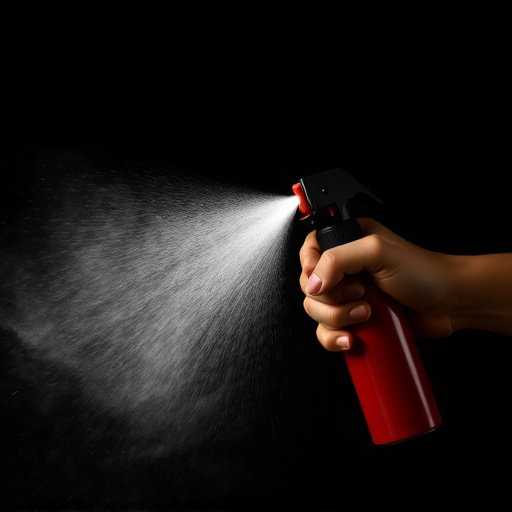Chemical irritants like capsaicin from chili peppers are key components in tactical reloading pepper spray canisters for self-defense, providing temporary discomfort and distance from threats. These canisters offer swift cartridge replacement, potent formulations, and robust construction for superior protection in high-risk environments. Selection requires balancing potency and safety, with concentration management and controlled dose mechanisms crucial to maximize attacker coverage while minimizing user exposure. Deployment must adhere to legal and ethical guidelines regarding consent, proportionality, and bystander safety, ensuring responsible use and public safety across jurisdictions.
In today’s world, personal protection is paramount. One effective tool gaining traction is the tactical reloading pepper spray canister, designed to incapacitate and deter threats instantly. Chemical irritants, the powerhouses behind these devices, play a crucial role in self-defense strategies. This article explores the science behind chemical irritants, delving into their functionality within personal protection devices. We’ll dissect the key features and benefits of tactical reloading pepper spray canisters while providing insights on selection, application, and legal considerations, empowering individuals to make informed choices for their safety.
- Understanding Chemical Irritants: Their Role in Personal Protection Devices
- Tactical Reloading Pepper Spray Canisters: Features and Benefits
- Selection and Application of Safe and Effective Chemical Irritants
- Legal and Ethical Considerations for Using Chemical Irritants in Self-Defense
Understanding Chemical Irritants: Their Role in Personal Protection Devices
Chemical irritants play a crucial role in personal protection devices like tactical reloading pepper spray canisters. These substances are designed to cause discomfort or pain when exposed to the eyes, skin, or respiratory system, enabling users to create distance from potential threats and gain time for escape or assistance. In the context of self-defense, understanding the properties and effectiveness of chemical irritants is essential for choosing the right protection device.
Tactical reloading pepper spray canisters, for instance, often utilize capsaicin, a compound derived from chili peppers, as their active ingredient. This irritant provokes an intense burning sensation, temporarily blinding and disorienting the assailant. The strategic use of such chemical irritants allows individuals to defend themselves effectively while adhering to legal restrictions on force, making them valuable components in personal protection strategies.
Tactical Reloading Pepper Spray Canisters: Features and Benefits
Tactical Reloading Pepper Spray Canisters are designed for those seeking enhanced personal protection in high-risk environments. These canisters boast a range of features that set them apart from standard pepper spray options. One key advantage is their reloading mechanism, allowing users to quickly replace spent cartridges, ensuring constant readiness. This is particularly beneficial in dynamic situations where quick refilling can be crucial.
Additionally, tactical canisters often incorporate powerful pepper spray formulas, delivering a strong irritant punch. They are crafted with durable materials and robust construction, making them resistant to harsh conditions. These features contribute to their reliability, providing users with peace of mind in potentially dangerous scenarios.
Selection and Application of Safe and Effective Chemical Irritants
When selecting chemical irritants for personal protection devices like tactical reloading pepper spray canisters, it’s crucial to strike a balance between potency and safety. The ideal irritant should be potent enough to deter attackers while minimizing the risk of unintended harm or adverse effects on users. Capsaicin, the active ingredient in chili peppers, is a popular choice due to its effectiveness and relatively low toxicity for humans. However, the concentration must be carefully considered to ensure it provides adequate protection without causing long-term health issues.
Application methods also play a vital role in ensuring safety and efficacy. Spray canisters, for instance, offer a straightforward and effective means of deploying irritants. The key is to design the spray mechanism to deliver a controlled dose that maximizes surface area coverage on the attacker while minimizing exposure to the user. Regular maintenance and testing of these devices are essential to guarantee their reliability in real-life situations, ensuring that the chemical irritant remains potent and the application system functions flawlessly.
Legal and Ethical Considerations for Using Chemical Irritants in Self-Defense
The use of chemical irritants in personal protection devices, such as tactical reloading pepper spray canisters, raises a complex web of legal and ethical considerations. On one hand, these substances are effective deterrents against potential threats, offering individuals a crucial tool for self-defense. The ability to deploy them swiftly and discreetly can prevent harm or even save lives in high-risk situations.
However, the ethical implications cannot be overlooked. The use of chemical irritants must adhere to strict regulations and guidelines to ensure responsible deployment. This includes considerations around consent, proportionality, and potential harm to bystanders. Furthermore, the legality varies across jurisdictions, with some areas having stringent rules on who can possess and use such devices, as well as specific conditions under which they may be employed. It’s paramount for users to understand these legal parameters and act within ethical boundaries to uphold public safety and avoid misuse.
In conclusion, chemical irritants, such as tactical reloading pepper spray canisters, play a crucial role in personal protection devices. Understanding their properties and proper application is essential for effective self-defense while navigating legal and ethical considerations. By selecting safe and effective irritants, individuals can empower themselves with a reliable tool to deter potential threats, ultimately enhancing their personal security.
